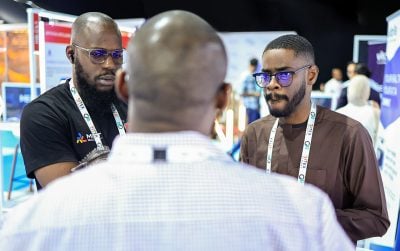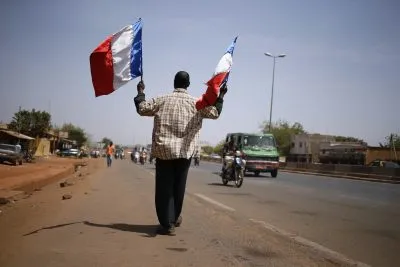It was May 7, 2014, an overcast Wednesday in Washington DC, and all the major breakfast shows were leading with the same harrowing tale. Thousands of miles away, in a remote Nigerian town called Chibok, 276 schoolgirls had been kidnapped from their dormitory on the night before their final exams. They’d been dozing on bunk beds, studying notes, or reading the Bible by flashlight.
They were high-school seniors, a few hours of test questions from graduating as some of the only educated young women in an impoverished region where most girls never learned to read.
Then a group of militants barged in, bundled them onto trucks, and sped into the forest. The students had become captives of a little-known terrorist group called Boko Haram, which filled its ranks by abducting children. The girls’ parents chased after them on motorbikes and on foot until the trail went cold.

For weeks, few people seemed to notice. The schoolgirls looked set to be forgotten, new entries on a long list of stolen youth. But this time, something mysterious aligned inside the algorithms that power the attention economy.
A small band of Nigerian activists on Twitter coined a hashtag calling for the hostages’ immediate release. Through the unpredictable pinball mechanics of social media, it shot out from West Africa and into the celebrity-sphere, boosted by Hollywood and hip-hop royalty, then captured the global imagination.
People all over the world began tweeting the same clarion call: #BringBackOurGirls. The network news channels found the story irresistible. Anchors choked up retelling a tragic sequence of events that seemed to connect the world’s richest and poorest people through the universal pain of parental loss. Here was a chance to take part in the crowdsourced liberation of more than two hundred innocent victims terrorized for their determination to learn.
Watching the news reports upstairs in the White House, Michelle Obama felt the same wrench of empathy that millions of others would express online: Those could be my daughters. She dialed her chief of staff. “I think I want to do this,” she said. “I want to do this.”
Her media team scrambled to choreograph the tweet. Staff hurried office supplies into the White House Diplomatic Room, trial-and-error testing Twitter photos in the same circular reception hall where Franklin Roosevelt once recorded his Fireside Chats. Michelle’s aides fumbled with different-size placards, and tested out sharpies to see how thick the marker should be for legibility on a small screen.
Michelle descended the staircase, rushing to a personal appointment. The motorcade was waiting, but she could do this fast. Standing opposite a portrait of George Washington, she stared intently into the photographer’s lens, gripping a pearly white placard: “#BringBackOurGirls.”
She dashed into her car, while an aide typed up her caption and clicked Tweet: “Our prayers are with the missing Nigerian girls and their families. It’s time to #BringBackOurGirls.—mo”
That modest gesture was liked or retweeted by some 179,000 people and seen by hundreds of millions across the world, becoming the most shared post of a frenzied campaign that tested the power of social media to reshape events thousands of miles away. In the space of a few weeks, two million Twitter users, with a tap of the screen, repeated the same demand.
How 82 of the schoolgirls were freed
In May 2017, three years after the kidnapping, the Boko Haram terrorist group freed 82 of the schoolgirls, who were by then young women. Many of the schoolgirls are still missing
The skies above northeastern Nigeria were empty except for one solitary aircraft. A soft rain streaked the windows of a Russian helicopter juddering through gray clouds. Inside the cabin, a Nigerian lawyer lifted a list and a pen from the chest pocket of his crisply ironed ash-colored kaftan and studied the names through thick-framed Calvin Klein spectacles. Across from him sat a diplomat from Switzerland, nervously ticking through the final preparations for Phase Two. If everything went according to plan, their team could still make the rendezvous point by 4:00 p.m.
The helicopter headed southeast, rumbling over thorn forests and villages torched and abandoned during almost a decade of war. On the roads below, lookouts would be monitoring them, the passengers assumed, tracking their movements. One misstep could shatter the process, years in the making. The operation, hashed out over endless encrypted messages and meetings in safehouses, hung on a pair of delicate concessions. The first involved five militants released from jail now being driven to the front lines. Second was a black bag stuffed full of euros in high-denomination notes, the currency Boko Haram had demanded. Its contents were strictly secret.
Only a few senior officials in either of their governments knew the agreement the two men and their small team of mediators had painstakingly engineered. Along the way, they had lost friends and contacts to assassinations and imprisonment and had mourned when previous deals collapsed. Each assumed their phones were tapped, their routines followed. Both had sworn to observe a total information blackout at each stage of an operation that could be undone by a single errant tweet or a picture posted on Facebook. Not even the lawyer’s family knew where he was.
They were the last in an army of would-be liberators, spies, and glory hunters that had descended on Nigeria to find a group of schoolgirl hostages that social media had transformed into a central prize in the global War on Terror.
A few days of tweets had lit a fuse of unintended consequences that had burned for years, the forces of Silicon Valley disrupting a faraway conflict on Lake Chad. Satellites had spun in space, scanning the forests of a region whose population had barely begun to use the internet.
The air power and personnel of seven foreign militaries had converged around Chibok, buying information and filling the skies with the menacing hum of drones. Yet none of them had rescued a single girl. And the fame that once started a race to free the young women had also prolonged their captivity.
The helicopter bumped to earth next to a military outpost ringed by half-buried tires and sand-filled oil drums with a chain of white Toyota Land Cruisers parked on the cracked tarmac. The two men stooped as they stepped off the helicopter and went their separate ways.
The lawyer entered the first car of a convoy that rattled north over a dusty road, passing deserted farmland and the charred mud-brick walls of villages whose few remaining residents were too old to leave. Outside the window lay fallow fields, overlain with discarded tools and an upside-down rust-coated wheelbarrow.
The area was notorious for land mines and roadside bombs. Each driver steered carefully into the tread marks left by the car in front, their bumpers mounted with fluttering Red Cross flags. The lawyer told himself there was nothing to fear: “The prayers of the orphans will protect you.”
His car halted, and its flashing brake lights signaled the convoy behind to stop. Fighters in fatigues, their heads wrapped in turbans, were gathered on the other side of the dirt road, standing alert beside waist-high grass. In the branches of acacia trees, and crouching behind bushes, the lawyer could see other figures, training their rifles. He held his list, the silence broken by the warning chime of a Toyota door left ajar.
In the distance he could see a snaking line of silhouettes, dozens of women wrapped in dark, floor-length hooded shrouds billowing in the breeze. They were stepping through long grasses flanked by armed men. The figures looked exhausted, each trudging awkwardly toward him. Two of them were walking on crutches, and one was missing her left leg below the knee. Another had her arm draped in a sling. One carried a baby boy on her back.

These were the students that millions had tweeted about, then forgotten, but none of them had any idea about the social media campaign, and they lacked the faintest notion that anybody except their parents had been advocating for their release. These schoolgirls, almost all Christians, had come of age in captivity.
To keep their friendships and faith, they had whispered prayers together at night, or into cups of water, and memorized Bible passages in secret. At risk of beatings and torture, they had softly sung gospel songs, fortifying each other with a hymn from Chibok: “We, the children of Israel, will not bow.”
The women, eighty-two in all, walked onto the road and halted opposite the lawyer, huddling into two lines, staring ahead with their eyes fixed. Some linked arms, others squeezed hands, their baggy clothes concealing the few possessions they’d managed to accumulate, strips of colored fabric and small twigs for pinning their hair.
One of the women was trailing behind, dressed in a gray shroud and walking with a slight hunch. Tied around her thigh, hidden from view, was something the men with guns had never found, an article of defiance. It was a secret diary, filling three notebooks, a firsthand record of the women’s ordeal.
Her name was Naomi Adamu. It was her 1,118th morning in captivity.

Want to continue reading? Subscribe today.
You've read all your free articles for this month! Subscribe now to enjoy full access to our content.
Digital Monthly
£8.00 / month
Receive full unlimited access to our articles, opinions, podcasts and more.
Digital Yearly
£70.00 / year
Our best value offer - save £26 and gain access to all of our digital content for an entire year!
 Sign in with Google
Sign in with Google 



